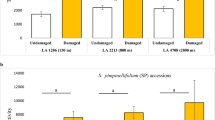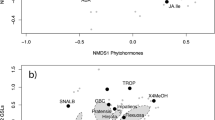Abstract
Plants are hypothesized to evolve increased defense against herbivores at lower latitudes, but an increasing number of studies report evidence that contradicts this hypothesis. Few studies have examined the evolution of constitutive and induced resistance along latitudinal gradients. When induction is not considered, underlying patterns of latitudinal clines in resistance can be obscured because plant resistance represents a combination of induced and constitutive resistance, which may show contrasting patterns with latitude. Here, we asked if there are latitudinal gradients in constitutive versus induced resistance by using genotypes of Oenothera biennis (Onagraceae) sampled along an 18° latitudinal gradient. We conducted two bioassay experiments to compare the resistance of plant genotypes against one generalist (Spodoptera exigua) and one specialist (Acanthoscelidius acephalus) herbivore. These insects were assayed on: i) undamaged control plants, ii) plants that had been induced with jasmonic acid, and iii) plants induced with herbivore damage. Additionally, we examined latitudinal gradients of constitutive and induced chemical resistance by measuring the concentrations of total phenolics, the concentration of oxidized phenolics, and the percentage of phenolics that were oxidized. Spodoptera exigua showed lower performance on plants from lower latitudes, whereas A. acephalus showed no latitudinal pattern. Constitutive total phenolics were greater in plants from lower latitudes, but induced plants showed higher total phenolics at higher latitudes. Oxidative activity was greatest at higher latitudes regardless of induction. Overall, both latitude and induction have an impact on different metrics of plant resistance to herbivory. Further studies should consider the effect of induction and herbivore specialization more explicitly, which may help to resolve the controversy in latitudinal gradients in herbivory and defense.




Similar content being viewed by others
References
Abdala-Roberts L, Moreira X, Rasmann S, Parra-Tabla V, Mooney KA (2016) Test of biotic and abiotic correlates of latitudinal variation in defences in the perennial herb Ruellia nudiflora. J Ecol 104:580–590
Agrawal AA, Hastings AP, Johnson MTJ, Maron JL, Salminen J-P (2012) Insect herbivores drive real-time ecological and evolutionary change in plant populations. Science 338:113–116
Anstett DN, Naujokaitis-Lewis I, Johnson MTJ (2014) Latitudinal gradients in herbivory on Oenothera biennis vary according to herbivore guild and specialization. Ecology 95:2915–2923
Anstett DN, Ahern JR, Glinos J, Nawar N, Salminen J-P, Johnson MTJ (2015) Can genetically based clines in plant defence explain greater herbivory at higher latitudes? Ecol Lett 18:1376–1386
Appel HM (1993) Phenolics in ecological interactions: the importance of oxidation. J Chem Ecol 19:1521–1552
Ardón M, Pringle CM, Eggert SL (2009) Does leaf chemistry differentially affect breakdown in tropical vs temperate streams? Importance of standardized analytical techniques to measure leaf chemistry. J North Am Benthological Soc 28:440–453
Berdegué M, Reitz SR, Trumble JT (1998) Host plant selection and development in Spodoptera exigua: Do mother and offspring know best? Entomol Exp Appl 89:57–64
Bingham RA, Agrawal AA (2010) Specificity and trade-offs in the induced plant defence of common milkweed Asclepias syriaca to two lepidopteran herbivores. J Ecol 98:1014–1022
Cleland, RE (1972) Oenothera: Cytogenetics and evolution, Academic Press, New York
Coley PD, Aide TM (1991) Comparison of herbivory and plant defenses in temperate and tropical broad-leaved forests. In: Lewinsohn TM, Fernandes GW, Benson WW (eds) Plant-animal Interaction: evolutionary ecology in tropical and temperate regions. Wiley, New York, pp. 25–49
Coley PD, Barone JA (1996) Herbivory and plant defenses in tropical forests. Annu Rev Ecol Syst 27:305–335
Coley PD, Bryant JP, Chapin FS III (1985) Resource availability and plant antiherbivore defense. Science 230:895–899
Creelman RA, Mullet JE (1997) Biosynthesis and action of jasmonates in plants. Annu Rev Plant Biol 48:355–381
Dobzhansky T (1950) Evolution in the tropics. Am Scientist 38:209–221
Feeny P (1970) Seasonal changes in oak leaf tannins and nutrients as a cause of spring feeding by winter moth caterpillars. Ecology 51:565–581
Hagerman AE, Butler LG (1991) Tannins and lignins. In: Rosenthal GA, Berenbaum MR (eds) Herbivores: their interactions with secondary plant metabolites, 2nd edn. Academic Press, New York, pp. 355–388
Hallam A, Read J (2006) Do tropical species invest more in anti-herbivore defence than temperate species? A test in Eucryphia (Cunoniaceae) in eastern Australia. J Trop Ecol 22:41–51
Hiura T, Nakamura M (2013) Different mechanisms explain feeding type-specific patterns of latitudinal variation in herbivore damage among diverse feeding types of herbivorous insects. Basic Appl Ecol 14:480–488
Johnson MTJ (2011) The contribution of evening primrose (Oenothera biennis) to a modern synthesis of evolutionary ecology. Pop. Ecol 53:9–21
Johnson MTJ, Agrawal AA (2005) Plant genotype and environment interact to shape a diverse arthropod community on evening primrose (Oenothera biennis). Ecology 86:874–885
Johnson MTJ, Agrawal AA (2007) Covariation and composition of arthropod species across plant genotypes of evening primrose (Oenothera biennis. Oikos 116:941–956
Johnson MTJ, Rasmann S (2011) The latitudinal herbivory-defence hypothesis takes a detour on the map. New Phytol 191:589–592
Johnson MTJ, Agrawal AA, Maron JL, Salminen JP (2009a) Heritability, covariation and natural selection on 24 traits of common evening primrose (Oenothera biennis) from a field experiment. J Evol Biol 22:1295–1307
Johnson MTJ, Smith SD, Rausher MD (2009b) Plant sex and the evolution of plant defenses against herbivores. Proc Natl Acad Sci U S A 106:18079–18084
Johnson MTJ, Ives AR, Ahern J, Salminen JP (2014) Macroevolution of plant defenses against herbivores in the evening primroses. New Phytol 203:267–279
Karban R, Agrawal AA (2002) Herbivore offense. Annu Rev Ecol Syst 33 :641–664
Karban R, Baldwin IT (1997) Induced responses to herbivory. University of Chicago Press, Chicago
Kempel A, Schädler M, Chrobock T, Fischer M, van Kleunen M (2011) Tradeoffs associated with constitutive and induced plant resistance against herbivory. Proc Natl Acad Sci U S A 108:5685–5689
Kozlov MV, Lanta V, Zverev V, Zvereva EL (2015) Global patterns in background losses of woody plant foliage to insects. Glob Ecol Biogeogr 24:1126–1135
Lehndal L, Ågren J (2015) Latitudinal variation in resistance and tolerance to herbivory in the perennial herb Lythrum salicaria is related to intensity of herbivory and plant phenology. J Evol Biol 28:576–589
Levin DA (1976) Alkaloid-bearing plants: an ecogeographic perspective. Am Nat 110:261–284
Levin DA, York BM (1978) The toxicity of plant alkaloids: an ecogeographic perspective. Biochem Syst Ecol 6:61–76
Lim JY, Fine PVA, Mittelbach GG (2015) Assessing the latitudinal gradient in herbivory. Glob Ecol Biogeogr 24:1106–1112
Louthan AM, Doak DF, Angert AL. (2015). Where and when do species interactions set range limits? Trends Ecol Evol 30:780–792
Martz F, Peltola R, Fontanay S, Duval RE, Julkunen-Tiitto R, Stark S (2009) Effect of latitude and altitude on the terpenoid and soluble phenolic composition of juniper (Juniperus communis) needles and evaluation of their antibacterial activity in the boreal zone. J Agric Food Chem 57:9575–9584
McArt SH, Halitschke R, Salminen J-P, Thaler JS (2013) Leaf herbivory increases plant fitness via induced resistance to seed predators. Ecology 94:966–975
McGuire RJ, Johnson MTJ (2006) Plant genotype and induced responses affect resistance to herbivores on evening primrose (Oenothera biennis. Ecol Entomol 31:20–31
Memelink J (2009) Regulation of gene expression by jasmonate hormones. Phytochemistry 70:1560–1570
Moles AT (2013) Dogmatic is problematic: interpreting evidence for latitudinal gradients in herbivory and defense. Ideas Ecol Evol 6:1–4
Moles AT, Ollerton J (2016) Is the notion that species interactions are stronger and more specialized in the tropics a zombie idea? Biotropica Early 48:141–145
Moles AT, Bonser SP, Poore AGB, Wallis IR, Foley WJ (2011a) Assessing the evidence for latitudinal gradients in plant defence and herbivory. Funct Ecol 25:380–388
Moles AT, Wallis IR, Foley WJ, et al. (2011b) Putting plant resistance traits on the map: a test of the idea that plants are better defended at lower latitudes. New Phytol 191:777–788
Moreira X, Mooney KA, Rasmann S, Petry WK, Carrillo-Gavilán A, Zas R, Sampedro L (2014) Trade-offs between constitutive and induced defences drive geographical and climatic clines in pine chemical defences. Ecol Lett 17:537–546
Moreira X, Abdala-Roberts L, Parra-Tabla V, Mooney KA (2015) Latitudinal variation in herbivory: influences of climatic drivers, herbivore identity and natural enemies. Oikos 124:1444–1452
Pearse IS, Hipp AL (2012) Global patterns of leaf defenses in oak species. Evolution 66:2272–2286
Pennings SC, Ho CK, Salgado CS, Wieski K, Dave N, Kunza AE, Wason EL (2009) Latitudinal variation in herbivore pressure in Atlantic coast salt marshes. Ecology 90:183–195
R Core Development Team (2012) R: A language and environment for statistical computing. R Foundation for Statistical Computing, Vienna, Austria. ISBN 3–900051–07-0, URL http://www.R-project.org
Rasmann S, Agrawal AA (2011) Latitudinal patterns in plant defense: evolution of cardenolides, their toxicity and induction following herbivory. Ecol Lett 14:476–483
Rauwolf U, Golczyk H, Meurer J, Herrmann RG, Greiner S (2008) Molecular marker systems for Oenothera genetics. Genetics 180:1289–1306
Salminen J-P, Karonen M (2011) Chemical ecology of tannins and other phenolics: we need a change in approach. Funct Ecol 25:325–338
Salminen JP, Karonen M, Sinkkonen J (2011) Chemical ecology of tannins: recent developments in tannin chemistry reveal new structures and structure-activity patterns. Chemistry 17:2806–2816
Schemske DW, Mittelbach GG, Cornell HV, Sobel JM, Roy K (2009) Is there a latitudinal gradient in the importance of biotic interactions? Annu Rev Eco Evol Syst 40:245–269
Strong, DR, Lawton, JH, Southwood, SR (1984) Insects on plants: Community patterns and mechanisms. Harvard University Press, Cambridge
Thaler JS, Stout MJ, Karban R, Duffey SS (1996) Exogenous jasmonates simulate insect wounding in tomato plants (Lycopersicon esculentum) in the laboratory and field. J Chem Ecol 22:1767–1781
Turcotte MM, Davies TJ, Thomsen CJ, Johnson MTJ (2014) Macroecological and macroevolutionary patterns of leaf herbivory across vascular plants. Proc R Biol Sci B 281:20140555
Więski K, Pennings S (2014) Latitudinal variation in resistance and tolerance to herbivory of a salt marsh shrub. Ecography 37:763–769
Woods EC, Hastings AP, Turley NE, Heard SB, Agrawal AA (2012) Adaptive geographical clines in the growth and defense of a native plant. Ecol Monogr 82:149–168
Acknowledgments
We thank QiChen Tang for assisting in data collection, Juha-Pekka Salminen and Jeff Ahern for technical advice, and Angela Lange for equipment. This study was in part funded by University of Toronto Mississauga’s Research Opportunity Program. This project was further funded by an NSERC CGS Vanier to D. Anstett and by an NSERC Discovery Grant, the Canadian Foundation for Innovation, and Ontario’s Early Researcher Award to M. Johnson.
Author information
Authors and Affiliations
Corresponding author
Additional information
Daniel N. Anstett and Alice Chen contributed equally to this paper.
Rights and permissions
About this article
Cite this article
Anstett, D.N., Chen, W. & Johnson, M.T.J. Latitudinal Gradients in Induced and Constitutive Resistance against Herbivores. J Chem Ecol 42, 772–781 (2016). https://doi.org/10.1007/s10886-016-0735-6
Received:
Revised:
Accepted:
Published:
Issue Date:
DOI: https://doi.org/10.1007/s10886-016-0735-6




